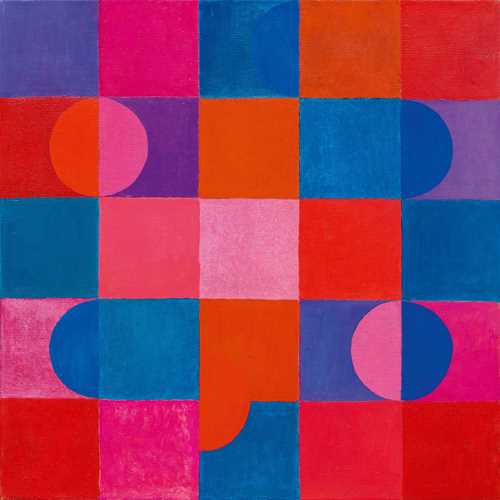
Lotto 3429* - A183 Postwar e contemporary art - sabato, 09. dicembre 2017, 14h00
JOHANNES ITTEN
Literature: Rotzler, Willy/Itten, Anneliese: Johannes Itten. Werke und Schriften, Zürich 1978, cat.no. 1146.
Exhibition:
- Venice 1966, Johannes Itten, Walter Link. 33th Biennale, Swiss Pavillon, June-October (verso with the label).
- Bern 1971, Gesamtausstellung. Kunsthalle Bern, September - October, cat.no. 194 (verso with the label).
- Unterengstringen 1976, Johannes Itten, Bilder und Studien. Schulhaus Büel, 24 April - 13 May (verso with the label).
- Ulm 1976, Johannes Itten, Bilder und Studien. Kunstverein, 30 May - 4 July (cat.cover) (verso with the label).
- Münster 1980, Johannes Itten. Gemälde, Gouachen, Aquarelle, Tuschen, Zeichnungen. Westfälisches Landesmuseum für Kunst und Kulturgeschichte, 24 August - 5 October, cat.no. 59 (verso with the label).
“Each creative work of art begins with an impulse of love from the heart, it grows, it enters the consciousness of the artist, through the intellect it becomes something concrete, controlled and measured through the perception of the external world, finally it is thrust into the world in the hour of its birth, and led towards independence and maturity with tender and judicious care." Johannes Itten
Johannes Itten is probably one of the most fascinating artistic personalities of the 20th century. He set the standards not only in painting, but also in art theory and art education. Scarcely any other artist identified and lived art as an all-encompassing experience as consistently as Itten.
Born in 1888 in the Bernese Oberland to a farming family, in 1904 Johannes Itten followed in his father’s footsteps and began his training as a teacher at the teachers’ college of the Canton of Bern. By 1909 he had made the decision to become a painter, but was not satisfied with the art studies on offer in Geneva. However, at that time in Geneva, in addition to artists and musicians, he also got to know Eugène Gillard, whose book on the principles of form would prove to be relevant to the young artist’s own theory of art. In 1913 he moved to Stuttgart to become a student of Adolf Hölzel, which marked the beginning of his artistic career. Under Hölzel he learned the formal analysis of colour and soon became one of his master students. Itten quickly turned to abstract painting and in a very short time he developed his own, independent style. By way of a parting gesture, Hölzel organised an exhibition for Itten with Herwarth Walden, which demonstrated the great respect and fondness that existed between teacher and student.
In 1916 the young artist gravitated towards Vienna where, as teacher in a private art school, he was able to try out and develop for the first time the educational concept on which he had been working for years. He encountered numerous avant-garde artists, became acquainted with twelve-tone music, and above all met Alma Mahler, who provided the contact with Walter Gropius.
With the founding of the Bauhaus school in Weimar in 1919, Gropius had achieved something unique and hitherto unknown: for the first time, the fine arts, the performing arts and applied arts were taught on equal terms, with the common goal of producing total art works under the primacy of functionality. Itten became the teacher of the so-called preparatory course, in which students learned the principles and rules of form and colour. From Itten’s point of view the students also achieved an awareness of where their strengths lay within the arts. Soon Johannes Itten, who saw a missionary purpose in his teaching activity, which he pursued and defended emotionally, and Walter Gropius, who was more rational and guided by reason, were to fall out and went their separate ways in 1922.
In 1929 Itten opened his own school in Berlin and in 1932 also became teacher at the newly founded school of textile design (Fachschule für Textile Flächenkunst) in Krefeld. As a former teacher of the Bauhaus, he was classed as a “degenerate artist” in 1933 when the Nazis seized power, which led to the closure of both art schools in the 1930s. In 1938 Itten decided to return to his home country, and became director of the school and museum of arts and crafts in Zurich. His longstanding interest in Asian art and philosophy culminated in 1952 with the founding of the Rietberg Museum in Zurich, which he also directed until 1956.
From the completion of his studies under Adolf Hölzel in 1916, until his return to Switzerland, Johannes Itten’s focus was on teaching and its development. He held numerous teaching posts and delivered countless lectures worldwide. The production of art was also an important element during this period, in that it served as a way for him to try out his theories, and he drew energy from his creative work.
In the last phase of his life, he directed his attention back to painting and created an outstanding body of work, from which the present piece “Zweiklang” comes. The strict, square form of the painting is divided into small rectangles of different sizes, which in their turn are broken up with circles and semi-circles. Various shades of blue and red lend the composition a warm radiance, which captivates the viewer. The work clearly demonstrates Itten’s acquaintance with the Zurich concrete artists, who dominated avant-garde art in Switzerland in the 1960s. Nevertheless, the small irregularities and infringements of the rules of geometry show his own independent style.
CHF 30 000 / 50 000 | (€ 30 930 / 51 550)
Venduto per CHF 102 500 (incl. premio dell'acquirente)
Non si assume alcuna responsabilità per la correttezza di queste informazioni.

